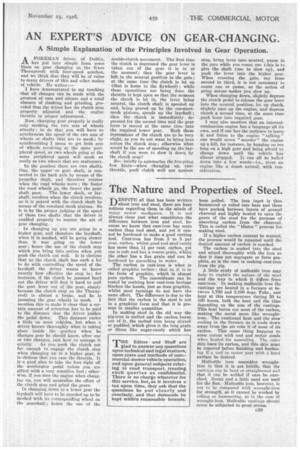The Nature and Properties of Steel.
Page 61

If you've noticed an error in this article please click here to report it so we can fix it.
1-NESPITE all that has been written 1../ about iron and steel, there are hazy notions regarding them in the minds of many motor mechanics. It is not always clear just what constitutes the difference between iron and steel, because we know that cast-iron has more carbon than tool steel, and yet it cannot be hardened to make a good cutting tool. Cast-iron has from 3 to 5 per cent. carbon, whilst good tool steel rarely has more than 1 per cent, carbon, yet one is soft and has a coarse grain, whilst the other has a fine grain and can be hardened by quenching in water.
The carbon in east-iron is what is called graphite carbon; that is, it is in the form of graphite, which is almost pure carbon. The resemblance can be tested by noticing how cast-iron borings blacken the hands, just as does graphite, whilst steel turnings do not have the same effect. The difference is due to the fact that the carbon in the steel is not in a graphitic form and that it is present in smaller quantities.
In making steel in the old way the pig-iron is melted and the carbon burnt out of it, the melted iron being stirred or puddled, which gives it the long grain or fibres like sugar-candy which has
been pulled. The iron ingot is then hammered or rolled into bars and these bars packeil, between layers of ground charcoal and highly heated to open the .pores of the steel for the purpose of absorbing carbon from the charcoal. This is called the " blister " process for making steel.
If a higher carbon content be wanted, the process would be repeated bath l the desired amount of carbon is reached.
The carbon is soaked into the steel and mixed thoroughly with the iron so that it does not segregate or form graphite, as is the case in making cast-iron from the pig.
A little study of malleable iron may help to explaiin the nature of the steel and the way in which it differs -from cast-iron. In making malleable iron the castings are heated in a furnace at between 1,700 and 2,100 dogs. Fehr., and kept at this temperature during 50 to 100 hours, both the heat and the time depending on the size of the castings. This heat burns out most of the carbon, making the metal more like wroughtiron. The continued heat and the slow' cooling in the furnace as it cools down away from the air robs it of most of its carbon. This same thing happens to some extent with tool and motor steels when heated for annealing. The outer skin loses its carbon, and this skin must be removed before finishing and hardening if a tool or motor part with a hard surface be desired.
" Malleable iron resembles wrought. iron in that it is not brittle, that the castings can be bent or straightened and that it cap be welded if care be exercised. Borax and a little sand are used for the flux, Malleable iron, however, is not to be compared with wrought-iron for strength, as it cannot be worked by rolling or hammering, as in the case of wrought-iron. Malleable castings should never be subjected to great stress.












































































































